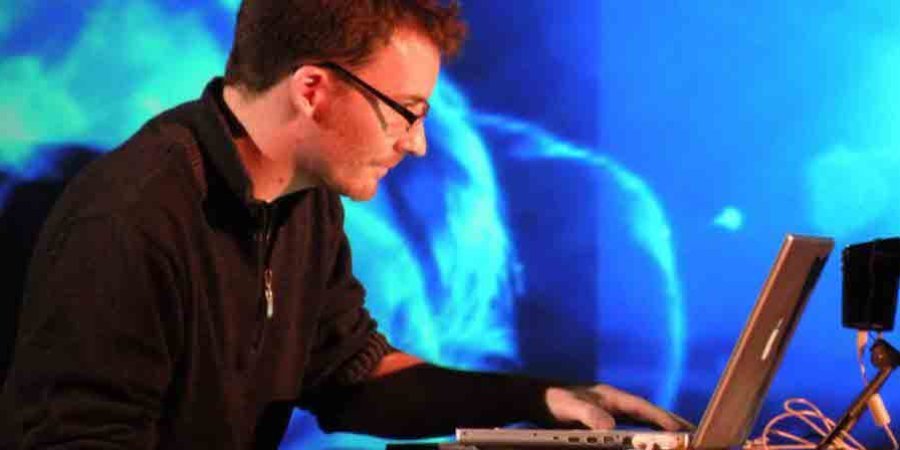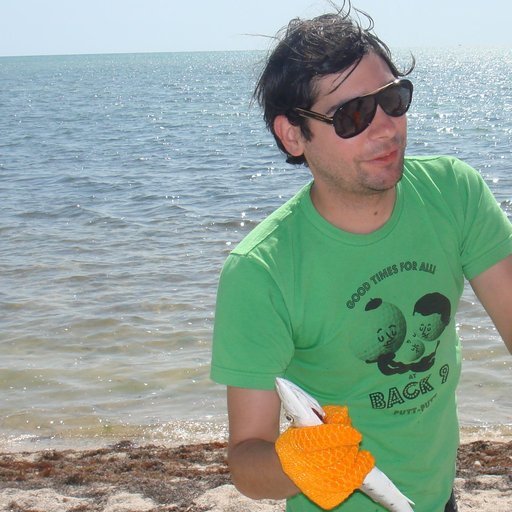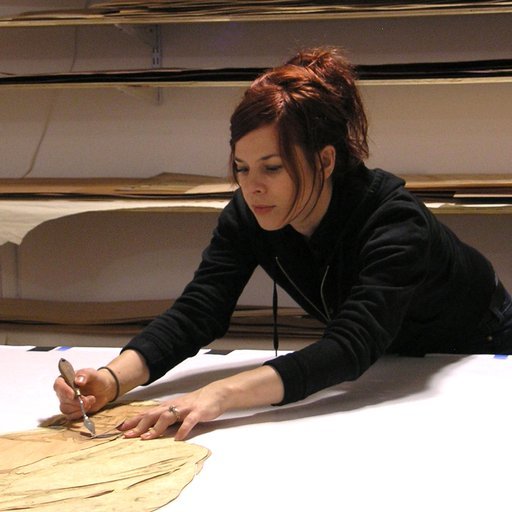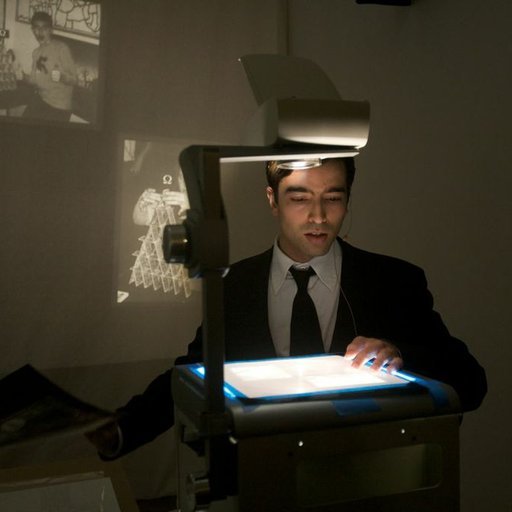Last week, the first museum survey of R. Luke DuBois's work opened at the John & Mable Ringling Museum of Art in Sarasota. In addition to new video work riffing on traditional circus posters that DuBois made during a residency at the museum, the show also will feature a sort of dual portrait of Google founders Sergey Brin and Larry Page, which was commissioned by the National Portrait Gallery in Washington, D.C. Changing notions of how people can be portrayed—and how we choose to portray ourselves in social media—is one strain that runs through DuBois's diverse body of work.
The Brin/Page depiction features video of each subject delivering speeches that were lifted from YouTube and melded together with word maps that change during the course of the video based on Google searches of the words in those speeches. DuBois is notable not only for his proficiency with such digital technology, but also for his thoughtful layering of meanings relating to both the subjects in such works and the media used to produce them.
For the Hindsight Is Always 20/20 project DuBois compiled the texts of each president's State of the Union addresses and reproduced the most common words in type that shrinks in the style of an eye chart—Lincoln's top word was "Emancipation"; Nixon's was "Truly." In another piece, he programmed computers to scour the internet for images of Britney Spears using facial recognition software, then overlay those images in a constantly shifting display in which her eyes remain perfectly centered. A More Perfect Unionused millions of online dating profiles to compare the words people use to describe themselves in different zip codes.
In addition to creating his visual art, DuBois works as a musician and composer and teaches in the Integrated Digital Media program at NYU's Polytechnic School of Engineering. We interviewed him by email about his choice of subjects, the creative process, and just what "technology" means.
Can you tell me about the new work made at the Ringling?
Circus Sarasota consists of five framed "circus posters," which are really single-channel generative video pieces with the screens mounted in bespoke frames and their images synchronized via computer networking. They each feature an individual circus act. We have Dolly Jacobs, the incredible aerialist; "Texas" Jack Fulbright, an amazing Western-style performer, et cetera. Each "poster" moves, using high-speed photography to capture the nuance of the incredible physical gestures these people do effortlessly.
They reference classic circus posters from the 19th century, like the Strobridge lithography posters made for the Ringling Bros. circus. I worked with an incredible type designer named Ksenya Samarskaya, who created a beautiful typeface for the project, and I use different types of visual compositing to show simultaneity of motion in the same manner as the posters did.
The beautiful thing about the classic American circus is the fact that it is largely unmediatized when experienced live. The performers have only their bodies and their physical props, and they use them effortlessly. Circus performers are truly incredible when they're working: they're strong as athletes, graceful as ballet dancers, and have the magnetism of stage actors. Watching Dolly spin through the air, or Gena Shvartsman Cristiani juggle, is like watching a movie star perform a physics equation in real time. Capturing it in a still medium wouldn't work, but neither would simply making a linear video, as it's really the interaction and the dialogue between the different actions they perform that interests me.
This work continues your exploration of performance. What attracts you to performance as a subject or theme?
I'm a musician, so performance has always been part of what I do. A lot of what I'm interested in exploring relates to the gesture, physicality, and temporality of performance. So I like collaborating with performing artists to develop scenarios that use time (a dimension that performance has as a defining feature) in an unusual way to illustrate something I find interesting about performance. It's revealing to accelerate something done slowly, or slow down gestures we normally experience at a more fleeting speed, or look at a mass action from a macro perspective by showing multiple points of view simultaneously. In this sense, the Circus Sarasota portraits continue in the same thread as Fashionably Late for the Relationship, Vertical Music, and The Marigny Parade, although this new piece is the first I've done that exists only as installation and never as a linear film.
These pieces also, to a degree, are about addressing a longstanding issue I have with the conflation of the performing arts and recording arts in contemporary society. Watching a theatrical performance is not the same thing as watching a video of a theatrical performance, and live music is very different than recorded music. So these pieces are all opportunities to create media works that take performance and generate new modes of portraiture rather than ersatz documentation.
They also serve as pieces of cultural advocacy, as the performing arts in American society are under siege. They're under-taught to children, and they're tragically under-funded at a professional level. Bringing them into a visual arts and cinematic context helps, in a small way, to remind people that there are performers out there in this country who can do these incredible things in real life, without special effects or multiple takes or editing, and we need to ensure that they stick around for generations to see.
How have your work as a musician and composer affected your approach to visual art?
I guess my background as a musician gives me an aptitude, or a predisposition, for working with (groan) "technology" and "data." But let me explain why I put those words in quotes. It's another pet peeve of mine. Somebody at some point decreed that artists starting using "technology" and "data" recently—in the 1970s, say. So to call bullshit on this, let's talk about music, which, last I checked, was made by people our society would recognize as artists.
The history of music is the history of technology. Instruments are technology; notation is technology; architectural acoustics are technology; amplification and phonography are (a bit more recent) technology. So unless you're improvising (or reciting from memory) vocal music and performing it, a capella, outdoors, you're using technology.
We're pretty sure people starting building interfaces for musical expression (i.e. instruments) around 40,000 years ago; we started notating music around 3,500 years ago, if not earlier; the acoustic properties of performing arts spaces were on the mind of literate individuals at least 2,000 years ago; recording and amplification are 19th century technologies that were perfected in the past 100 years. Every civilization uses the maximum level of technology available to it to make art, so please don't tell me "technology" in the arts is a recent phenomenon. Unless you really just mean "electricity and computation," which is what 99 percent of people mean when they say "technology," because we're so culturally narcissistic now that we've forgotten about what happened before we had those things.
Speaking of notation, most (but not all) musical cultures worldwide have evolved over thousands of years to develop systems of, let's call them informatics. Pitches, rhythms, notational standards, performance practices, et cetera. The melakarta, a collection of melodic scales (raga) employed in the Classical tradition of South India, was first written down sometime in the 16th century CE—and this is a compendium, remember; the scales have been around a lot longer than that. The metric cycles of rhythm (e.g. Javanese bentuk) used in gamelans are traditionally sourced to somewhere around the 3rd Century CE. Western European art music has a long, rich tradition of harmony that is fairly new by comparison, but yields an incredibly rich source of complexity for music from 19th-Century symphonies to Jazz.
These musical systems are all algorithms, and the events generated by musicians in response to the systems are DATA. Musicians don't refer to them as data; we call them notes, chords, keys, melodies, et cetera. Nor do musicians and listeners necessarily internalize music as data, but it's data nonetheless, and we've been making art by manipulating it for thousands and thousands of years.
So, again, I guess my background as a musician gives me an aptitude, or a predisposition, for working with (groan) "technology" and "data." I'm also more attuned to the ways in which technology and data can be used to create works that have emotional resonance. After all, what is music but a combination of technology and data designed to make you feel something?
To create many of your works you amass large data sets and sort through them to find patterns—a strategy that seems more relevant than ever after revelations about the NSA in recent months. Nonetheless, your artwork ultimately takes on much deeper issues. How do you see the relation between the artwork and the technology? Is it just a tool like a tube of paint?
As I said above, we've always used "technology." The term itself is disingenuous. A tube of paint is technology, too. The only thing that electricity and computation gets us is the ability to automate and manipulate information and present it in different media with a degree of fluidity and precision that was not as easy to pull off, historically. Artists have that power now, but so does Facebook, Google, and the NSA. Just as the democratization of print let the cat out of the bag on the controlled transmission of literature, the democratization of computing machines gives artists the ability (and arguably the duty) to leverage the same tools to comment on how they're being used more broadly in society.
A lot of my pieces have an inherent critique of their own technology built-in. Some of this critique is non-controversial (Hindsight Is Always 20/20 can be seen as a subtle jab at tag clouds, which were all the rage in 2007; Vertical Music uses high-speed recording to experience something you usually can't, which is a studio recording of a chamber ensemble in performance, complete with visuals, at 1/10th speed), but some of it is a ticking time bomb.
For example, if you really think about how I made A More Perfect Union, you're not going to like it. In 2010, I violated the privacy of 20 percent of the adult population of the United States. That means that, at some point, I was in possession of a hard drive with the highly personal writing of you, your friends, and your family, and used it to make maps. I did this because it's what our country does as a matter of course when it makes a census (albeit with different data), and I wanted to create an alternative vision of what that census could be, based our self-identity. Joshua Decter reviewed Perfect Union for Artforum when it premiered at bitforms gallery, and he pointed out that I'm "in a privileged position to both shape and redeploy massive amounts of human information, which implies a significant amount of control, even if the objective is to produce a mode of service-based artistic practice." He's absolutely right, and in that sense, electricity and computation are a bit more complicated than a tube of paint.
In 1,000 years, though, or even perhaps 100, none of this will be controversial, or even interesting, and the fact that we insist on using the words "new" and "media" in the way we talk about it will be greeted with a bemused smirk at our shortsightedness. I know how to program a computer. In 100 years—assuming we can get our shit together and fix the educational system on this planet (a big assumption, granted)—everyone will know how to program a computer. Hopefully by then we'll have the literacy to match the technique, so that we can keep saying interesting things using it as a tool.
Your works seem to foreground a subject—political rhetoric or the language of love—while the tech that was used in making it sits in the background, so it seems the subjects always come first. Do you ever start with some new technology you discover and then try to find the right subject to fit with it?
Technological innovation in society will often provoke a comment from me, but it's never the case of "Wow! That's a cool new toy! Let me come up with something right now for that!" I think at some point I tried that strategy, but discovered it led to lazy thinking and a slippery slope towards techno-fetishism. It's more of a complex mishmash of ideas and subjects floating around in my head that I occasionally have eureka moments and marry.
A good example of that is called Pop Icon: Britney, which is a portrait of Britney Spears that repurposes a lot of DARPA-funded computer vision research originally intended for finding a specific person (Osama Bin Laden, for example) within a large database of arbitrary video. I knew I wanted to make something about Britney Spears, because she's a fascinating cultural figure who plays a unique, fascinating, and heartbreaking role in the Simulacra and Simulation nightmare that is AutoTune, Photoshop, and the mainstream record industry at the turn of the century. I assigned some of these computer vision research papers for a class at NYU, and it just sort of clicked that I needed to implement them to make a machine for finding the one woman on Earth who would never need to be found in this way.
In general, though, I think it's far more interesting (and a bigger challenge) to figure out what you want to talk about (but not necessarily what you want to say) and then start searching for the right metaphor, which leads you, eventually, to the tools you need for the job.
Even looking at just the works that might appear under the rubric of portraits, you tend to present your subjects in such varied ways. What is the creative process like for you, as you work toward eventually finding the final format for presentation?
[The curator] Dan Cameron once paid me the compliment of saying that I had a "complete disinterest in making art that conforms to any previous notions of style." So the "varied ways" you speak of may have something to do with that, but it's also very true that I have a postmodern approach to what you might call the implementation phase of a project.
Some subjects strongly suggest a form: if you're going to speed up all the Academy Award Best Picture winners, you should probably do it as a single-channel video shown in a darkened movie theater, that helps drive home the point. Hindsight Is Always 20/20 became a series of eye charts because I was watching James Carville on CNN at 3am and he kept using the expression "lack of vision" to describe George W. Bush.
Sergey and Larry's portrait was largely inspired by the premise of using the Google search engine on its creators, in order to see what happens when you Google the Googlers, so to speak. It was envisioned as an exercise in culture jamming with raw data instead of media. So for that I had to learn all about the men who founded Google, but also their algorithm, their company, and the technology they were making available to me as a third-party developer. I decided that the best move was to give myself some constraints: I would try to make the entire piece using nothing but Google-owned products and services. So the portrait is an avant-garde mashup of YouTube, where I got the source interviews of my subjects; Android speech recognition, which I used to subtitle them; and Google image and text search APIs, which I used to literally google everything they say while they say it. All of this is running inside of a generative media playback and rendering engine I developed myself.
As for how any given work looks in the end, that's a much more experimental process, but I usually create an arsenal of potential visual layouts and mockups before arriving at something fixed. With the Google portrait, I repurposed what I knew of the Plumb Design Thinkmap algorithm, which created visual connections between concepts in a database, to create a "cat's cradle" of highly abstracted text coming out of the google search engine. The intent in this case is to be more aesthetic than informative, and to really emphasize the massive amount of interconnected information attached to the simplest of searches.
Is there a typical timeline during which you work through such issues?
My pieces tend to take a while. I don't have a really specific production timeline that I adhere to, but A More Perfect Union was three years in the making, and the Brin/Page portrait took a solid year to get into shape. A lot of time is spent in what a filmmaker would consider pre-production. Some of this is software development and testing, but increasingly a lot of this work looks like the kind of research that a documentary filmmaker would do before starting a new piece.
For The Marigny Parade, I was going back and forth to New Orleans for two years planning what ultimately was a twenty-minute performance that I edited into a DVD-length video work in three months. When I'm working with performers, the process is quite collaborative, and cultural place-making is an important component of some of my projects, so I try when working with circus performers in Sarasota, Florida, or marching band musicians in New Orleans, to learn as much as I can about the cultural context in which they work, before I even start on producing raw material.
How do you see the concept of portraiture expanding and changing in today's digital world?
I think Brin/Page (Google) portrait that I made for the National Portrait Gallery is a nice hybrid of representational and abstract portraiture. You see the subjects' faces as they speak, but you also see what their language represents. I think language is a largely untapped realm in portraiture that computing tools can help unlock. We can sample, cut up, analyze, and visualize linguistic data very quickly and easily, so I'm hoping that as these tools become common currency the idea of doing someone's portrait will expand to include their words, their voices, their use of language, so that, for example, an artist working solely with sound or a printmaker who works with typography will be able to make as compelling a portrait of a subject as a painter 100 years ago.























